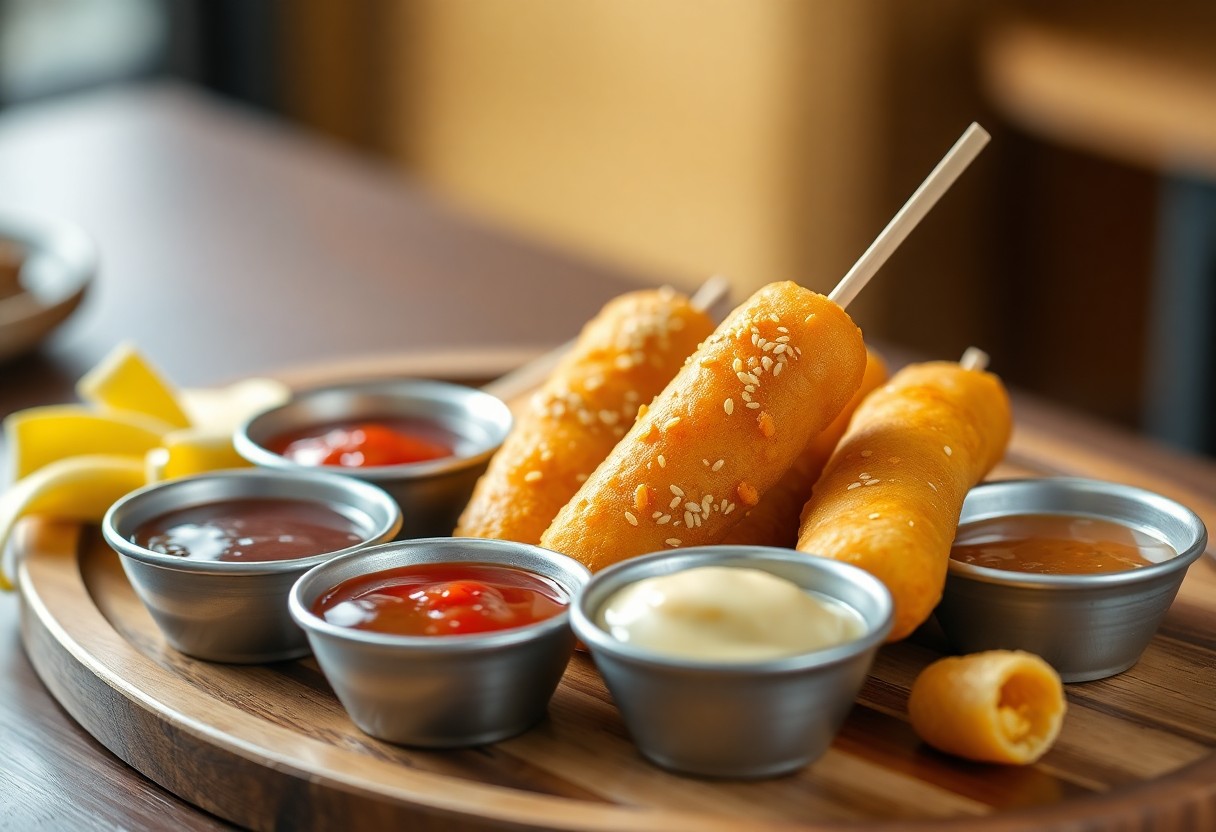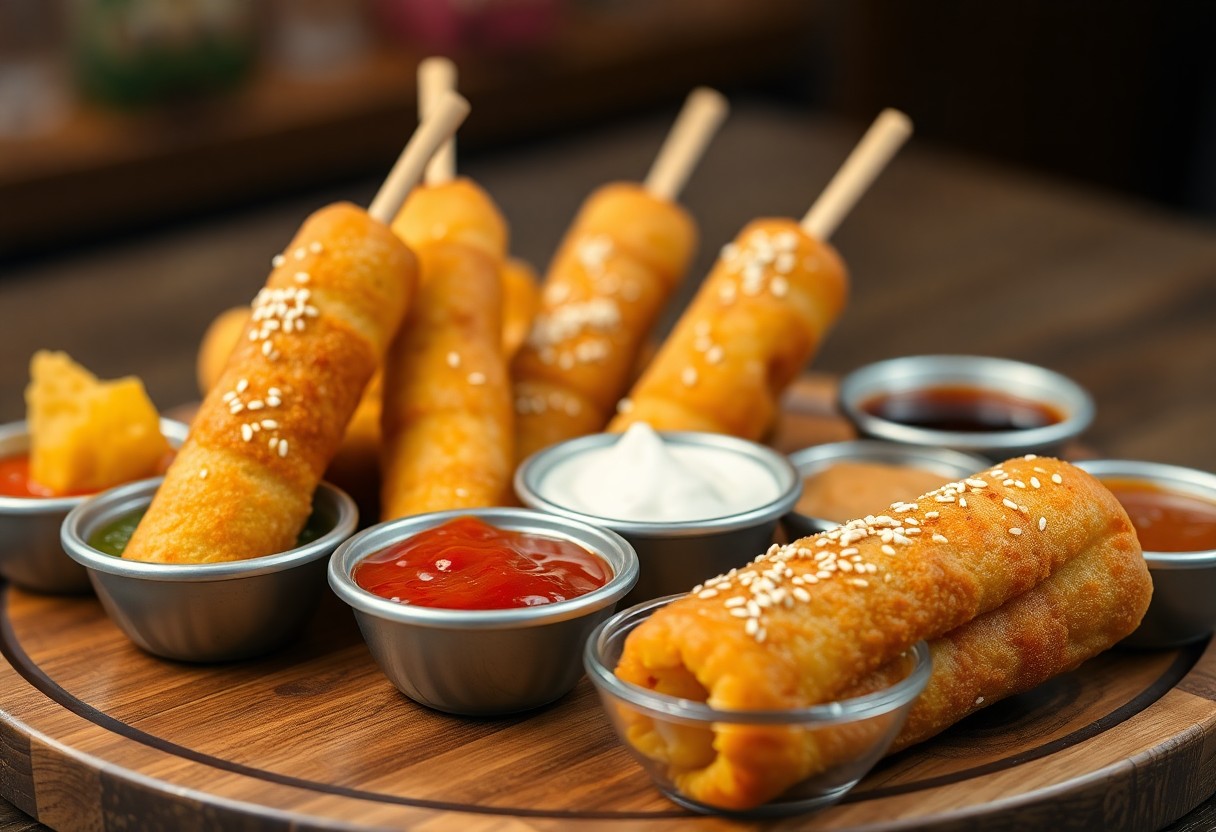How Do You Make Korean Corn Dogs at Home?
Corn dogs might be an American classic, but Korean corn dogs take this beloved street food to a whole new level. You’re about to discover how to recreate these crispy, cheesy, and utterly delicious treats right in your kitchen. Unlike traditional corn dogs, your Korean-style version will feature a distinctive sweet and crispy coating, often studded with potato chunks or other creative toppings. While they might look intimidating at first, you’ll find that making these Instagram-worthy snacks is surprisingly manageable with the right ingredients and technique.
Ingredients Needed
For your homemade Korean corn dogs, you’ll need a combination of basic pantry staples and specific Asian ingredients. The recipe requires two main components: the filling and the coating. While some ingredients are vital for achieving that authentic Korean corn dog taste and texture, others can be customized to your preference.
Essential Ingredients
You’ll need hot dogs or mozzarella cheese sticks for the filling, all-purpose flour, cornmeal, sugar, instant yeast, milk, and vegetable oil for frying. The batter requires milk, eggs, sugar, and salt. For the exterior coating, prepare panko breadcrumbs and your choice of seasonings.
Optional Additions
Essential extras can elevate your Korean corn dogs from good to outstanding. Popular options include potato cubes, crispy ramen noodles, or crushed cornflakes for coating. For toppings, consider sugar, ketchup, mustard, or mayo. Korean hot sauce adds an authentic touch.
The beauty of Korean corn dogs lies in their versatility. You can mix and match different coatings and fillings to create your signature version. Combine cheese varieties, add diced onions to your batter, or experiment with sweet options like condensed milk drizzle. Your creativity is the only limit.
Preparing the Batter
Some of the most important steps in making Korean corn dogs happen during the batter preparation. Your batter needs to achieve the perfect consistency – thick enough to coat the filling but not too dense to create a heavy coating. The right mix of ingredients and proper technique will give you that signature crispy exterior while maintaining a soft, chewy interior that Korean corn dogs are famous for.
Choosing the Right Flour
Choosing all-purpose flour as your base will give you reliable results, but you can elevate your corn dogs by using a mix of flours. You’ll get the best results with a combination of all-purpose flour and rice flour, which creates that distinct crispy texture. A ratio of 2:1 all-purpose to rice flour works well for achieving the authentic Korean corn dog texture.
Mixing Techniques
Flour needs to be properly combined with your wet ingredients to create a smooth, lump-free batter. You’ll want to start by whisking your dry ingredients together before gradually incorporating the wet components. The final batter should have a consistency similar to pancake batter – thick enough to coat the back of a spoon but still able to drip off smoothly.
To achieve the perfect batter consistency, you should mix until all ingredients are just combined – avoid overmixing as this can develop too much gluten and result in a tough coating. Your batter will need to rest for about 15-20 minutes before use, allowing the flour to fully hydrate and any air bubbles to rise to the surface.
Preparing the Hot Dogs
The preparation of hot dogs is a key step in creating authentic Korean corn dogs. You’ll need to handle your hot dogs with care, ensuring they’re at the right temperature and properly prepared before coating. Your hot dogs should be completely thawed if frozen, and patted dry to ensure better batter adhesion.
Selecting the Right Hot Dogs
For the best Korean corn dog experience, you should choose all-beef hot dogs that are about 6 inches in length. Your selection matters as the quality and size of the hot dog will impact the final taste. You can also experiment with cheese-filled hot dogs or combine both cheese and hot dogs for a more indulgent version.
Skewering Tips
Right before coating, you’ll need to secure your hot dogs properly on wooden skewers.
- Insert the skewer through the center of the hot dog
- Leave about 4 inches of stick at the bottom for handling
- Make sure the hot dog is straight on the stick
This proper skewering technique ensures even coating and cooking.
Selecting the right skewering method can make or break your Korean corn dog preparation.
- Soak wooden skewers in water for 30 minutes
- Use skewers that are at least 8 inches long
- Check that skewers are sturdy enough to hold ingredients
This attention to detail will help you achieve professional-looking results.
Frying the Corn Dogs
Keep your corn dogs crispy and perfectly cooked by maintaining proper frying techniques. The success of your Korean corn dogs heavily depends on the frying process, where temperature control and timing play important roles. You’ll need to monitor the oil temperature and follow specific methods to achieve that signature golden-brown exterior while ensuring the inside is thoroughly cooked.
Oil Temperature Factors
Little details make a big difference when it comes to oil temperature control.
- Test oil with wooden chopsticks – bubbles should form steadily
- Use a deep-frying thermometer for accuracy
- Maintain oil temperature between 350-375°F
- Avoid overcrowding the pot
Temperature Guide
| Too Low (below 350°F) | Greasy, soggy result |
| Too High (above 375°F) | Burnt exterior, raw interior |
Assume that your oil temperature is correct when small bubbles form around a wooden chopstick inserted into the oil.
Frying Method Tips
Assuming you’ve prepared your battered corn dogs properly, follow these guidelines for perfect results:
- Lower corn dogs slowly into oil
- Rotate continuously for even cooking
- Fry for 5-6 minutes until golden brown
- Remove when coating is crispy
With proper technique, you’ll achieve that signature crispy exterior and fluffy interior. Keep the corn dogs moving in the oil to prevent sticking and ensure even cooking. Your attention to detail during this stage will determine the final texture and taste. Perceiving the right golden-brown color is your cue to remove them from the oil.
Serving Suggestions
Despite their delicious taste straight from the fryer, Korean corn dogs benefit from thoughtful presentation and accompaniments. You can serve them on a platter lined with parchment paper or in classic paper holders for that authentic street food experience. To enhance your corn dog enjoyment, consider cutting them in half diagonally to showcase the filling and make them easier to share.
Traditional Accompaniments
Suggestions for authentic Korean corn dog sides include shredded cabbage, pickled radish, or a light cucumber salad. You can sprinkle additional sugar, or add a dusting of cheese powder to your corn dogs just before serving. A small side of kimchi adds a traditional Korean touch and helps balance the richness of the corn dog.
Dipping Sauce Ideas
For the ultimate Korean corn dog experience, you’ll want to prepare a selection of dipping sauces. Popular options include honey mustard, sweet chili sauce, spicy mayo, ketchup mixed with gochujang (Korean red pepper paste), or a combination of soy sauce and rice vinegar.
This variety of sauces allows you to customize each bite according to your taste preferences. You can mix and match different sauces, creating unique flavor combinations. Sweet and spicy combinations work particularly well, and you might discover your own signature sauce pairing that complements the crispy exterior and cheesy interior of your homemade Korean corn dogs.
Common Mistakes to Avoid
Once again, making Korean corn dogs requires attention to detail and proper technique. While the process might seem straightforward, several common pitfalls can affect your final result. From getting the right batter consistency to achieving the perfect cooking temperature, understanding these potential issues will help you create restaurant-quality corn dogs at home.
Batter Consistency Issues
There’s a fine line between too thick and too thin batter. If your batter is too runny, it won’t stick properly to your ingredients and will create a thin, uneven coating. On the other hand, if it’s too thick, you’ll end up with a heavy, doughy exterior that doesn’t cook evenly. Your batter should coat the back of a spoon and slowly drip off, similar to pancake batter consistency.
Over or Under Cooking
You need to maintain the right oil temperature throughout the cooking process. When your oil is too hot, the outside will brown quickly while the inside remains raw. If it’s too cool, your corn dogs will become greasy and soggy.
Mistakes in cooking time can ruin your Korean corn dogs. Watch for a golden-brown color and rotate them frequently for even cooking. Test one by cutting it in half – the interior should be fully cooked with no raw batter, and the cheese should be melted but not completely leaked out.
Conclusion
Ultimately, making Korean corn dogs at home allows you to customize this popular street food to your taste while saving money. With the right ingredients, proper temperature control, and attention to coating techniques, you can achieve that signature crispy exterior and cheesy interior that makes these treats so irresistible. By following the steps outlined above, you’ll master the art of creating these delicious snacks, impressing your friends and family with your culinary skills. Whether you choose traditional hot dogs or experiment with alternative fillings, your homemade Korean corn dogs will rival those from any street vendor.









